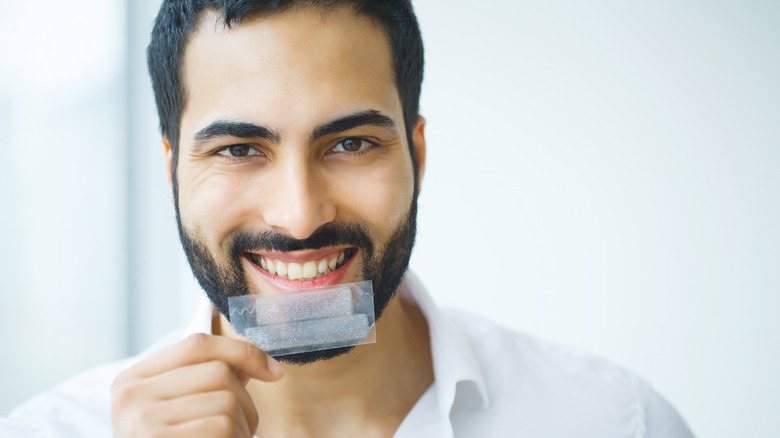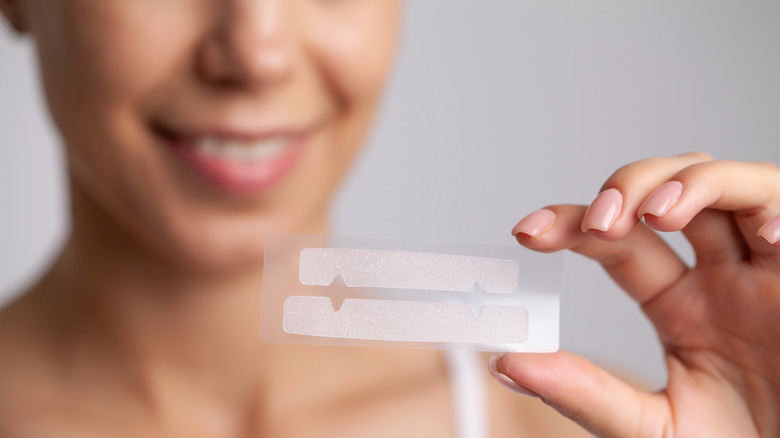What Happens If You Leave Whitening Strips On Too Long?
Able to be used in the privacy and comfort of your own home, whitening strips are a popular alternative to professional teeth whitening treatments that would otherwise be performed in a dentist's office. Although whitening strips can be purchased over-the-counter at your local drugstore, it doesn't mean they're free from potential side effects, cautions Belmont Dental. Just like any other product, it's important to follow the instructions as outlined to ensure your health and safety.
The main ingredient in teeth whitening strips — either hydrogen peroxide or carbamide peroxide — is what produces their desired effect, explains Eagle Harbor Dental. When the strip is applied to the surface of the teeth, the chemicals go to work ridding the teeth of molecules that cause staining. Essentially bleaching the tooth, whitening strips can be effective in mitigating the appearance of surface-level stains (via Belmont Dental).
Although it might seem like longer wear times would produce better results, leaving whitening strips on for too long can produce some uncomfortable side effects. To help reduce these risks, experts at Belmont Dental advise that individuals only purchase whitening products approved by the American Dental Association (ADA). Similarly, Barron Family Dental advises against purchasing whitening strips online and encourages users to stick to products that contain no more than 10% peroxide content.
How to use whitening strips
To use your whitening strips, open the packaging and apply the gel-coated side directly onto the surface of the teeth with light pressure, explains Eagle Harbor Dental. The remaining flap that hangs off the bottom of the teeth should be folded back and secured to the underside of your teeth. Check to make sure the top of the whitening strip is adjacent to your gum line. Pro-tip: while it seems logical to brush your teeth before or after whitening strip use, dental experts say you'll want to refrain from doing so. Pairing whitening strips with teeth brushing can make the surface of the tooth slippery and, therefore, more challenging to attach to one's teeth. You'll also reduce any potential interactions with the whitening gel and toothpaste after the fact.
When it comes to how much time whitening strips should spend attached to your teeth, instructions may vary by brand. For example, instructions for Crest Whitestrips state that the product should remain intact for no more than five minutes, while some of their more heavy-duty whitening products can be left in place for a half-hour. For this reason, it's important to follow the instructions as outlined, including how often the product should be used.
Potential side effects of wearing whitening strips longer than instructed
Wearing whitening strips beyond the instructed time limit can lead to gum irritation in the form of chemical burns, according to Eagle Harbor Dental. You may also notice the presence of white spotting immediately after use, but this discoloration is generally temporary. Additionally, Belmont Dental cautions that tooth sensitivity may also set in if you've left whitening strips on for too long. This can often be the case if you're using a product with a higher peroxide content, as the gel can aggravate the nerves in our teeth — Ouch! Similarly, tooth enamel can begin to break down if the product does not include ingredients to counterbalance the pH level.
If you are thinking about giving whitening strips a go, consider consulting with your dentist beforehand. Generally speaking, whitening treatments are not advised for children, those who are pregnant, nursing, or people with veneers, dental crowns, or bondings, explains Barron Family Dental.



